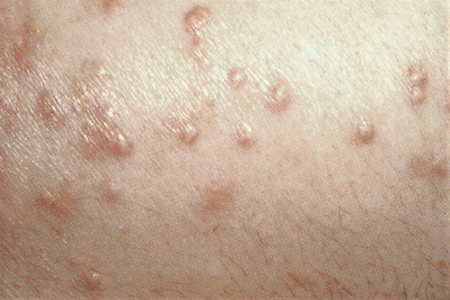Resumo
Definição
História e exame físico
Principais fatores diagnósticos
- eruptive xanthomas
- lipemia retinalis
Outros fatores diagnósticos
- increased BMI/waist circumference
- lipodystrophy
- features of coronary artery disease
- claudication
- neurologic features
- recurrent abdominal pain
Fatores de risco
- family history of hyperlipidemia
- high saturated fat diet
- high carbohydrate or high glycemic index diet
- excessive alcohol consumption
- family or personal history of overweight/obesity
- family or personal history of diabetes
- insulin resistance
- liver disease
- renal disease
- HIV infection
- use of certain drugs
- Cushing syndrome
- inflammatory/immune disorders
- organ transplant
- hypothyroidism
- pregnancy
Investigações diagnósticas
Primeiras investigações a serem solicitadas
- triglyceride level
Investigações a serem consideradas
- apolipoprotein B
- fasting plasma glucose
- BUN, creatinine
- urinary albumin/protein
- serum albumin
- thyroid-stimulating hormone
- liver function tests
- C-reactive protein
Algoritmo de tratamento
chylomicronemia
moderate HTG (fasting TG ≥150 mg/dL [≥1.7 mmol/L] or nonfasting TG ≥175 mg/dL [≥2.0 mmol/L] and TG <500 mg/dL [<5.6 mmol/L])
severe HTG (fasting TG ≥500 mg/dL [≥5.6 mmol/L] especially fasting TG ≥1000 mg/dL [≥11.3 mmol/L])
Colaboradores
Autores
Robert A. Hegele, MD, FRCPC, Cert Endo, FACP, FAHA
Jacob J. Wolfe Distinguished Medical Research Chair
Martha Blackburn Chair in Cardiovascular Research
Distinguished University Professor of Medicine and Biochemistry
University of Western Ontario
London
Ontario
Canada
Declarações
RAH reports consulting fees from Acasti, Aegerion, Akcea/Ionis, Amgen, Boston Heart, HLS Therapeutics, Novartis, Pfizer, Regeneron, Sanofi and UltraGenyx. RAH is an author of references cited in this topic.
Agradecimentos
Dr Robert A. Hegele would like to gratefully acknowledge Dr David Alexander Leaf, the previous contributor to this topic.
Declarações
DAL declares that he has no competing interests.
Revisores
Vinaya Simha, MBBS, MD
Associate Professor
Mayo Clinic
Rochester
MN
Declarações
VS declares that he has no competing interests.
Créditos aos pareceristas
Os tópicos do BMJ Best Practice são constantemente atualizados, seguindo os desenvolvimentos das evidências e das diretrizes. Os pareceristas aqui listados revisaram o conteúdo pelo menos uma vez durante a história do tópico.
Declarações
As afiliações e declarações dos pareceristas referem--se ao momento da revisão.
Referências
Principais artigos
Grundy SM, Stone NJ, Bailey AL, et al. 2018 AHA/ACC/AACVPR/AAPA/ABC/ACPM/ADA/AGS/APhA/ASPC/NLA/PCNA guideline on the management of blood cholesterol: a report of the American College of Cardiology/American Heart Association task force on clinical practice guidelines. Circulation. 2019 Jun 18;139(25):e1082-143.Texto completo Resumo
Laufs U, Parhofer KG, Ginsberg HN, et al. Clinical review on triglycerides. Eur Heart J. 2020 Jan 1;41(1):99-109c.Texto completo Resumo
Berglund L, Brunzell JD, Goldberg AC, et al; Endocrine Society. Evaluation and treatment of hypertriglyceridemia: an Endocrine Society clinical practice guideline. J Clin Endocrinol Metab. 2012 Sep;97(9):2969-89.Texto completo Resumo
Virani SS, Morris PB, Agarwala A, et al. 2021 ACC expert consensus decision pathway on the management of ASCVD risk reduction in patients with persistent hypertriglyceridemia: a report of the American College of Cardiology Solution Set Oversight Committee. J Am Coll Cardiol. 2021 Aug 31;78(9):960-93.Texto completo Resumo
Mach F, Baigent C, Catapano AL, et al. 2019 ESC/EAS guidelines for the management of dyslipidaemias: lipid modification to reduce cardiovascular risk. Eur Heart J. 2020 Jan 1;41(1):111-88.Texto completo Resumo
Jellinger PS, Handelsman Y, Rosenblit PD, et al. American Association of Clinical Endocrinologists and American College of Endocrinology guidelines for management of dyslipidemia and prevention of cardiovascular disease. Endocr Pract. 2017 Apr;23(Suppl 2):1-87.Texto completo Resumo
Artigos de referência
Uma lista completa das fontes referenciadas neste tópico está disponível para os usuários com acesso total ao BMJ Best Practice.

Diagnósticos diferenciais
- Diabetes
- Lipodystrophies
- Liver disease
Mais Diagnósticos diferenciaisDiretrizes
- Guidelines for the primary prevention of stroke
- Cardiovascular disease: risk assessment and reduction, including lipid modification
Mais DiretrizesFolhetos informativos para os pacientes
High cholesterol
Mais Folhetos informativos para os pacientesConectar-se ou assinar para acessar todo o BMJ Best Practice
O uso deste conteúdo está sujeito ao nosso aviso legal